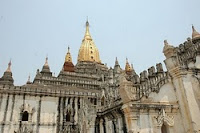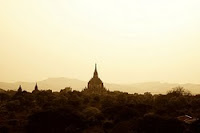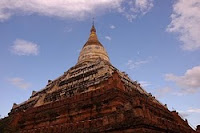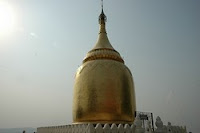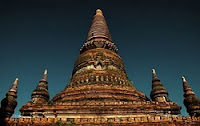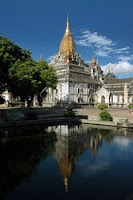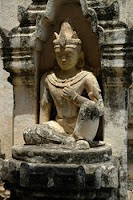Myanmar Thingyan
Thingyan is probably the most celebrated, most joyous event in the culture and custom of Myanmar people. From the poorest to the richest in Myanmar, this is the greatest event for the year. Every body, poor, rich, uneducated, educated, young and old all participate and enjoy in this once a year event. For every Burmese, this is the event not to be missed. Even for those Burmese people in foreign countries, this is the time for a celebration in the memory of their homeland and their culture. Thingyan is indeed the event for every Burmese, in Myanmar or outside.
Thingyan is actually not a true traditional Burmese custom. It is an imported cultural event, incorporated and extensively modified over several hundred years to become essentially a true Burmese cultural event. The origin of Thingyan can be traced back to India where it is one of the events of Hindi culture. The culture of Thingyan was brought into Burma by many Indian Brahmins who came to Burma to serve in the courts of Burmese kingdoms. As these Indian Brahmins held important positions in the court of Burmese kings, their culture, tradition and believes had great influence on the culture and tradition of Burmese royal courts. Thingyan is one of their cultural influences in the life of Burmese people.
The recorded Thingyan in the history of Burma was in Bagan era in the 13th century. Burmese historical accounts described the celebration of Thingyan in the royal court of Bagan. In one event, the king of Bagan, Nara Thiha Pathae ordered the ladies of his royal court to throw water at one of his wives to soak. Taking this as an act of humiliation, the wife took her revenge by plotting assassination against the king. However, the assassination plot was found out and the wife, together with all her relatives, was executed by burning alive. This is the earliest record of Thingyan in Burmese history.
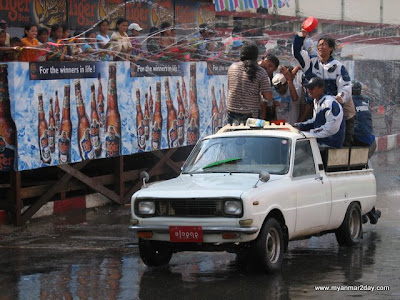
The background of Thingyan is the celebration of the Burmese New Year (which actually is a modification of Indian calendar). Burmese New Year falls during the month of April. Every year, the Brahmins of The Burmese Calendar Committee advised on the government to the date of the Burmese New Year day. Thingyan is celebrated for three days prior to the New Year day. However, in certain years, Thingyan is celebrated for four days. The number of days is calculated by the Brahmins of the Calendar Committee.
Today, Thingyan is celebrated all over Myanmar. Every city, town and village celebrates Thingyan. This is the event for everyone. Rich and poor alike become the same during Thingyan. This is the time where all social and cultural barriers break down in Myanmar. If you have been to Myanmar before and you already have an idea of what Myanmar people are like, you will find a different aspect of Myanmar life and Myanmar people. You will see the most joyous, fun loving and wildest part of Myanmar people during Thingyan.

During Thingyan, people throw water at each other. People pour water from the cup, splash water from a bucket, spray water using water guns or pipes. In the past, people used to throw water in water balloons which can be very painful. Fortunately, this is now prohibited as it is quite painful and dangerous to the one on the receiving end. Another way of spraying water that used to be quite common was using water canons (strong water canons like those used by firefighters!) and pressurized water guns (the same one used by your car wash!). The former one can knocked you out of your car while the latter one is very painful and can cause serious abrasions on the skin. These methods of playing with water are now banned by the government.
Similar water festivals are held throughout South East Asia during Thingyan. For example, Thai Songkran is quite famous and well known among foreigners. However, Myanmar Thingyan is quite unique among all these water festivals. During Thingyan, all the offices, supermarkets and departments stores are closed while many shops and restaurants also close. Roads are totally blocked by pick up trucks and jeeps full of people who go out to get splashed and wet. Stages were constructed along main roads and people throw water from these stages at these on trucks and jeeps. Many people, including some girls, become drunk and there are occasional fights break out among young people. However, during Thingyan, most people restrain from getting angry and out of control. Boys and girls tease each other freely (which is not always permissible in normal circumstances) and this they take it without any offence. Every body get soak during this time and every body welcome a splash of water during this hottest time of the year. However, monks and pregnant women are exempted from this as it is considered very rude to throw water at monks and pregnant women.
After Thingyan is the Burmese New Year Day. On The New Year Day, everything returns to normal. Wild and mad people who occupied the streets of cities and towns all across Myanmar totally disappeared, replaced by clean, gentle and polite individuals clad in traditional longyi heading to pagodas and monasteries. A visitor might be quite amazed by this total change of behavior in the people overnight. However, this is how Thingyan changed behavior of ordinary Burmese citizens during that joyous three days.
For those of you who want to have a taste of what Myanmar Thingyan look like, here is a video documentary from Youtube.
Thingyan , the Myanmar New Year Festival
EVERYONE, EVERYWHERE IS SPLASHING each other with water from hoses, buckets and anything else that'll hold water, screaming and shouting, all in good humored merriment. All are drenched, and no one cares. A splash is meant to be a compliment and water will continue to fly in every direction until dusk.
Whether you're a local or foreigner, let yourself get soaked and stay healthy in the happy year ahead; as the auspicious water of the Thingyan Festival is the Myanmar way of ushering in the New Year.
The Thingyan Festival is observed with much job and merry making in all parts of the country, from the remotest hamlet to the bursting cities like Yangon, the capital and Mandalay.
Thingyan comes from the Pali (spoken Sanskrit) word Thinkanta which means a "changeover," referring to the transition from the old year to the new year. The timing of New Year's day, based on the Myanmar Lunar calendar every year. It occurs at the end of the first month of the Myanmar calendar, called Tagoo, which usually falls within the month of April in the Western calendar. Thingyan, the water festival is customarily celebrated for a period of three or four days up to the New Year's day. Since it is the hottest time of the year in Myanmar, just about everyone-the young and the not-so-young, the pious and the not-so-pious, local and foreign alike - take part in the water-dousing ritual with fun, enthusiasm and abandon.
Desent of the Heavenly King
According to the tradition, the astrologer compute the start of Thingyan by studying the positions of the various constellations. Burmese believe that this is the time of Thagyamin, the King of Celestial Gods, descends to earth. Myanmar Buddhists consider him as the caretaker of the Buddhist religion and revere him greatly.
On the eve of Thingyan, just about eve Myanmar household prepares an earthen pot filled with seven flowers representing seven days of the week, and places it in front of the house to welcome the descending Heavenly King. The period of Thingyan is determined by the length of his stay, i.e. the day of his descent, an intervening day (or two days in some years) and the day of his ascent.
For centuries Burmese have been celebrating Thingyan by dousing each other liberally with water. Water which symbolises cleanness, is supposed to wash off the impurities of the old year while, at the same time, serving as a welcome coolant amid summer heat and humidity. In the old days, the proper-custom was to carry the scented water in silver bowls and sprinkle each other gently using sprigs and eugenia.
Buckets and hoses may have largely replaced the silver bowls today, but the spirit remains the same. During Thingyan, revellers throng the main streets of Myanmar's cities. Here and there, beautifully decorated pavilions and stands are erected for water dousing and entertainment.
Hydrants, which have been carefully serviced over the preceding few weeks, are at their full power to supply hoses aimed at merrymakers. Sprays of water and shouts of Thingyan good wishes seem to fill the air. No one escapes. In fact, everyone is anxious to drench and get drenched as dousing is considered an act of compliment.
Originally Not A Buddhist Festival
In recent years, an increasing number of foreigners, including tourists, businessmen and members of the diplomatic community, take part in the merriment with utmost enthusiasm.Although Thingyan days are public holidays, most hotels, restaurants and shops stay open to cater to the revellers. Apart from the dousing, it is also a Thingyan custom to set up marquees for offering food to one and all. A typical Thingyan delicacy is Montloneyebor, which can be translated loosely as "floating dough balls," They are dumplings made of glutinous rice stuffed with brown sugar and served with grated coconut. Thingyan, like some other festivities celebrated in Myanmar, is not of Buddhist origin, but comes from traditional beliefs and customs. But as Burmese became devout Buddhists many centuries ago, they were no longer satisfied with treating it purely as an occasion for merry-making and amusement, and began to seek spiritual merits in it in the Buddhist context.
During the festivities as well as on New Year’s day itself, many Burmese thus visit Buddhist monasteries to offer alms to monks and observe Buddhist rites. Some gather at pagodas to wash Buddha images and clean the pagoda compounds. Commonly observed merit-making customs at this time also include the "saving" of fish destined for the market and cattle destined for the slaughter house.
Young people also accrue merits by paying homage to old folks of their town or village, manicuring, then bathing them and washing their hair. Some young people temporarily join Buddhist orders; young men and boys become monks while girls become nuns.
One widespread belief among the people is that the aforementioned Thagyarmin descends to the earth bearing two parchment books. In one made of gold, he is said to list the names of those doing good deeds, while in the other made of dog skin, he supposedly lists the names of evil-doers.
It is also believed that good deeds performed on New Year’s day, i.e. the day after Thagyarmin’s ascent, will bring good luck for the whole year. So the people stop their merry-making and concentrate, instead, on deeds that are considered meritorious, such as cleaning their houses from top to bottom, laundering all their dirty linen or washing their heads with traditional "shampoo." In the evening, they invite monks to their homes to have them recite sacred Buddhist verses in Pali to ward off evil spirits.

Young girls dance during Myanmar's traditional Thingyan Water Festival in Yangon, April 13, 2010. (Xinhua/Jin Fei)

People enjoy spraying water to each other during Myanmar's traditional Thingyan Water Festival in Yangon, April 13, 2010. (Xinhua/Jin Fei)

People enjoy spraying water to each other during Myanmar's traditional Thingyan Water Festival in Yangon, April 13, 2010. (Xinhua/Jin Fei)

Young people pour water to each other during Myanmar's traditional Thingyan Water Festival in Yangon, April 13, 2010. (Xinhua/Ding Lingling)
People enjoy spraying water to each other during Myanmar's traditional Thingyan Water Festival in Yangon, April 13, 2010. Thingyan Water Festival kicked off on Tuesday and will run for four days.
Thingyan is the Myanmar new year festival
It is held in the month of Tagu every year. That has been the tradition since Tagaung Period and it became prominent in Bagan Period. The time and action at the water festival is very similar to Songkran water festival in Thailand.
Water is a symbol of coolness, clearness and cleansing of dirt and grime. The festival of Thingyan that is made most merry and enjoyable with pouring or throwing water on one another is taken as one that cleanses one and all of all dirt and grime of the old year and cools and clears the minds of the people for the new year.
Merry-making at Thingyan festival is intermingled with noble and pure activities of doing meritorious religious deeds in accord with the teachings of Buddha Dhamma.
| Myanmar is full of very interesting festivals and the number one festival is Thingyan or water festival, very similar to Songkran festival in Thailand. Over time Myanmar integrated plenty of festivals from other countries into their festival schedule typical is Diwali the Indian festival of lights. Myanmar Thingyan Festivalor Myanmar New Year Water Festival is performed everywhere in the country and lots of water flows down the pipes and buckets. Every Myanmar has a great time during Thingyan. According to the Myanmar calendar, Thingyan or New Year Day falls on every second week in April. Thingyan or water festival is celebrated for 3 days. Thingyan water festival has been celebrated in Myanmar since about 500 years ago. Thingyan means -moving from one year to another year. But nobody really knows why the Myanmar people throw water onto each other, maybe it has something to do to overcome the dry weather season and get a taste for the rainy season to come. |  Thingyan 2008  Water Festival Yangon |
|
Another idea is during Thingyanto wash away the sins committed during the whole year. Myanmar or maybe not only Myanmar, they have committed sins the whole year and maybe these sins could be washed away during Thingyan and clear mind and spirit by throwing Thingyan Water. Now everyone is completely innocent and can start making sins again. For merit making younger people wash the hair of old people during Thingyan. Another custom during Thingyan is to buy some fishes and let them loose into rivers or lakes on the last day of Thingyan. |
 Water Festival Myanmar |  Thingyan Photo |
 Myanmar Thingyan Festival |  Thingyan Festival |
 Thingyan in Yangon |
Myanmar Thingyan Festival
Thingyan is actually not a true traditional Burmese custom. It is an imported cultural event, incorporated and extensively modified over several hundred years to become essentially a true Burmese cultural event. The origin of Thingyan can be traced back to India where it is one of the events of Hindi culture. The culture of Thingyan was brought into Burma by many Indian Brahmins who came to Burma to serve in the courts of Burmese kingdoms. As these Indian Brahmins held important positions in the court of Burmese kings, their culture, tradition and believes had great influence on the culture and tradition of Burmese royal courts. Thingyan is one of their cultural influences in the life of Burmese people.
The recorded Thingyan in the history of Burma was in Bagan era in the 13th century. Burmese historical accounts described the celebration of Thingyan in the royal court of Bagan. In one event, the king of Bagan, Nara Thiha Pathae ordered the ladies of his royal court to throw water at one of his wives to soak. Taking this as an act of humiliation, the wife took her revenge by plotting assassination against the king. However, the assassination plot was found out and the wife, together with all her relatives, was executed by burning alive. This is the earliest record of Thingyan in Burmese history.
Myanmar Thingyan Festival will start on April 13 this year. But it might come a bit earlier from those Myanmar celebrating Thingyan overseas. May you all have fun at the water festival.

History
The origin of Thingyan, however, is not Buddhist but Hindu. The King of Brahmas called Arsi lost a wager to the King of Devas, Śakra (Thagya Min), who decapitated Arsi as agreed but put the head of an elephant on the Brahma's body who then became Ganesha. The Brahma was so powerful that if the head were thrown into the sea it would dry up immediately. If it were thrown onto land it would be scorched. If it were thrown up into the air the sky would burst into flames. Sakra therefore ordained that the Brahma's head be carried by one princess devi after another taking turns for a year each. The new year henceforth has come to signify the changing of hands of the Brahma's head.
Water Festival
The next day called a-kya nei is when Thingyan truly arrives as Thagya Min makes his descent from his celestial abode to earth. At a given signal, a cannon (Thingyan a-hmyauk) is fired and people come out with pots of water and sprigs of tha byay, then pour the water onto the ground with a prayer. A prophesy for the new year (Thingyan sa) will have been announced by the brahmins (ponna) and this is based on what animal Thagya Min will be riding on his way down and what he might carry in his hand. Children vill be told that if they have been good Thagya Min will take their names down in a golden book but if they have been naughty their names will go into a dog book!
Serious water throwing does not begin until a-kya nei in most of the country although there are exceptions to the rule. Traditionally, Thingyan involved the sprinkling of scented water in a silver bowl using sprigs of tha byay, a practice that continues to be prevalent in rural areas. The sprinkling of water was intended to metaphorically "wash away" one's sins of the previous year. In major cities such as Yangon, garden hoses, huge syringes made of bamboo, brass or plastic, water pistols and other devices from which water can be squirted are used in addition to the gentler bowls and cups, but water balloons and even fire hoses have been employed! It is the hottest time of the year and a good dousing is welcomed by most. Everyone is fair game except monks and obviously pregnant women. Some overenthusiastic young lads may get captured by women, who often are their main target, and become kids of a practical joke with soot from cooking pots smeared on their faces. Maidens from mandats with dozens of garden hoses exchange hundreds of gallons of water with throngs of revellers and one float after another. Many revellers carry towels to block the jet of water getting into the ear and for modesty's sake as they get thoroughly soaked and drenched in their light summer clothes. The odd prankster might use ice water and a drive-by splash with this would provoke shrieks of surprise followed by laughs from its victims. Pwè (performances) by puppeteers, orchestras, dance troupes, comedians, film stars and singers including modern pop groups are commonplace during this festival.

Myanmar Cute and Beautiful Girl Thet Mon Myint. She is with a red traditonal dress and she dance the myanmar thingyan traditional dance.I think this photo is from myanmar thingyan 2010.










